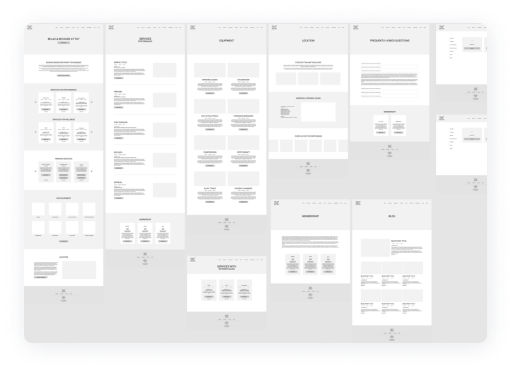Services provided
- Discovery
- UX/UI Design
- Digital Development
- System Integration
- Business Transformation
Solution technology
SimplyBook.me & WordPress
Key statistics
- 70+ user stories created
- 30+ booking platforms reviewed
- 13-week engagement
Client Background
TH7 BodyLabs is a flagship sports performance, recovery and wellness centre that provides tailored therapeutic sessions to clients based on their individual needs.
Tom Harvey and Greg Spurgin’s vision for TH7 BodyLabs was born from the belief that the latest performance, recovery, and wellness therapies shouldn’t only be available to professional athletes. They recognised that we all rely on our bodies and regardless of if you’re a weekend cyclist or park runner, part of a professional or social sports team, training for an endurance event, or simply work in a high-stress environment, you’re at your best when your body is too.
Having sourced the best equipment from around the world and developed evidence-based protocols that amplify the equipment’s benefits, TH7 BodyLabs ensures there’s a place where athletes (social, semi-professional or professional) and everyday people can revive, relax, re-focus, and feel ready for life’s demands every day.

Problem Overview
TH7 recognised that their premium in-centre offering needed to be matched by a clean and easy-to-use digital experience, that provided a frictionless platform for customers to seamlessly discover the benefits of their equipment and various health and wellness protocols, and then quickly and efficiently book a session as frictionlessly as possible.
Codex was appointed by TH7 to complete the Discovery, design and build of their integrated website and booking platform, ready for the grand opening in West End in late 2022.
Phase 1: Discovery
The Digital team at Codex commenced Discovery with a series of workshops and activities to clearly define the product vision, target audience, and user stories for both customers and staff. This involved creating detailed personas and customer journey maps based on those personas, as well as customer journey maps for several of their nearest competitors.
With over 70 user stories generated, and 11 distinct customer journeys mapped, a clear set of general requirements became apparent:
The website and booking platform needed to integrate seamlessly, on both desktop and mobile.
Customers with varying tech literacy should be able to easily navigate, book and manage their sessions with TH7.
The booking platform needed to be robust enough to handle complex resource availability, with the majority of services requiring more than one piece of equipment in a particular order.
The booking platform needed to be easy for staff to use, whilst not sacrificing key functionality such as large group bookings, rescheduling, and alternative payment methods (such as gift cards, packages and memberships).
The booking platform needed suitable APIs and accompanying documentation for future system integration, reporting, and data transfer.
The website needed to be able to facilitate dynamic content display, with equipment and protocols (a series of equipment scheduled in a scientific, evidence-based order) closely linked to each other.

This information led to the development of 39 functional requirements, which were then thematically analysed to identify 21 key criteria that were used to undertake an initial high-level assessment of 30 booking platforms.
Eight of these systems appeared to offer the majority of functionality TH7 required, and were reviewed in more depth against the full set of functional requirements. This involved reviewing documentation, speaking to sales representatives from each platform, starting free trials and testing the software.
The top three platforms from this process then underwent a final qualitative analysis, which included running a quick trial of the platform to understand the administrative interface, and mapping potential opportunities and risks in a SWOT analysis.
The results of this comprehensive analysis determined that SimplyBook.me was the online booking platform that best met their requirements. Furthermore, the preferred platform would also integrate well with the proposed custom-designed WordPress website.
For full transparency and referenceability, at the end of Discovery, a 46-page Discovery Report was presented to the TH7 BodyLabs team, which included:
Objectives, Key Results and Timeline Roadmap
Product Vision Board
Personas
Competitor Insights
Customer Journey Maps: Competitors
Customer Journeys
User Stories
Market Review
Platform Analysis
Functional Requirements
Non-Functional Requirements
Low-Fidelity Wireframes
User Testing
Recommendations
Phase 2 & 3: Execution & Deliverables
Phase 2 & 3: Design & Development
Design commenced with a round of low-fidelity wireframes, which were created based on the user stories and customer journeys generated during Discovery.
Online user testing sessions were then conducted with a small cohort of potential website users to rectify any obvious user experience issues, before seeking approval to go ahead with the high-fidelity mock-ups. Once approved by TH7, we began creating the high-fidelity mock-ups, working closely with Tom, Greg and their marketing agency to ensure alignment with their business goals, developing brand imagery/tone, and customer requirements.
The TH7 brand needed to appeal to everybody. Whether it was the weekend warrior cyclist and father of two, the busy yoga enthusiast who knows the importance of staying healthy, or the professional ultra-marathon runner who invests 24/7 into their fitness. The website was envisioned to be:
- Aesthetic
- Educational
- Accessible

The information architecture of the website evolved over the design period, with valuable input coming from the marketing team, potential clients and SEO experts. A comprehensive round of user experience testing of the high-fidelity wireframes identified some critical insights into the overall UX, including: the need for the protocols to be clearly defined, so users fully understood their benefits; updating the equipment and protocol finder UX to make the benefits filters more intuitive; and making content about the venue itself more prominent.
This feedback was implemented, and the Figma designs finalised. Our detailed preparation meant that the initial build of the WordPress website was straightforward, with Figma mock-ups quickly translated into HTML, CSS and JavaScript.
The user interface was designed to seamlessly scale to multiple screen sizes, supported by some intelligent WordPress logic and custom PHP code. Equipment (such as an ‘Infrared Sauna’) has been implemented in a way that it can easily be added/removed from protocols at the touch of a button – allowing TH7 to change their product offering, add new equipment or new services, without major changes to the website. Similarly, health benefits, timing, prices and imagery can be adjusted with little-to-no technical knowledge.
The SimplyBook.me widget allows for custom CSS, and is easily integrated into a page on the TH7 website, meaning customers do not need to navigate to multiple websites or browser tabs to complete a purchase. Book now buttons are strategically positioned throughout the site, supporting a customer’s purchasing decision and immediately taking them to the relevant stage in the booking workflow.
Given the complex nature of TH7’s equipment utilisation, some manual optimisation of resource allocation was required. The Codex team undertook extensive analysis to determine the best method for mapping the intersecting availability of individual equipment and the protocols they were part of. The results of this analysis were transposed into SimplyBook.me, allowing TH7 to offer more services and maximise revenue.
Supported by a final round of user testing, the TH7 website was switched live in late 2022 as planned.


The key takeaways when integrating your booking platform with your website
Having a clear differentiator from your competitors isn’t enough to launch a business and have it remain viable more than a year later. Numerous other businesses exist with recovery equipment, such as saunas, float tanks and plunge pools, but no-one manages to combine them into science-backed protocols like TH7.
In today’s operating climate, the physical business model must work harmoniously with the digital customer experience to ensure engagement barriers are minimised or eliminated. Our four key takeaways from the successful website and booking platform integration are:
Conduct a thorough Discovery before implementing a booking platform.
We found as many booking platforms as possible during Discovery, and there’s no doubt still more systems out there. Although this market saturation appears overwhelming, it’s important to adequately assess your options before diving into a booking platform. What works for your competitors may not necessarily work for you. Plenty of systems we reviewed appeared to have a large market share and were very popular (such as Mind Body) but ultimately didn’t suit the needs of TH7. By conducting discovery on behalf of TH7, we were able to recommend the best tool for the trade, without burdening them with complex decisions or analysis paralysis.
Don’t be afraid to push your chosen system to its full potential.
We would be surprised to find another SimplyBook.me and WordPress installation that look like TH7’s setup. Their business’s complex needs meant that we had to re-think the way certain features in SimplyBook.me were used, in order to deliver the best possible experience to both their customers and their staff. No system will be perfect, but utilising your tools to their fullest potential will eliminate the need to introduce other unnecessary platforms or upgrade systems too soon after rolling out.
Involve your potential customers early, and test frequently.
The transition from Discovery to Design and then Build was seamless, due to the early use of user testing. We received constant feedback throughout the entire process, which meant that we didn’t need to make any major changes when building and integrating the platforms, as all the hard work and decisions were already accounted for.
Collaborate reliably.
We know that through transparency and reliable collaboration, we can achieve transformational outcomes. Questions were answered when they arose, and daily check-ins were conducted to ensure both sides could raise issues to ensure they have a chance to be dealt with early.
The website is live at https://th7bodylabs.com.au/.
Testimonial

Greg Spurgin
Co-founder
TH7 BodyLabs
At TH7, we were looking for a unique booking platform to implement the sale of a fixed inventory at risk of expiring. The team at Codex listened to our brief, researched the market, and then developed a booking system that allowed us to achieve our inventory optimisation goals. We have been and continue to be impressed by the work ethic, communication, professionalism and after-service care provided by Codex to ensure implementation was smooth and streamlined. We firmly believe that our investment in the Codex team will prove to be a game changer for TH7 BodyLabs.



